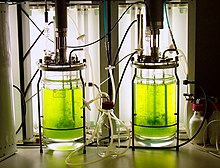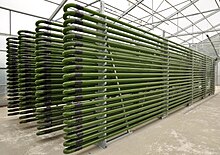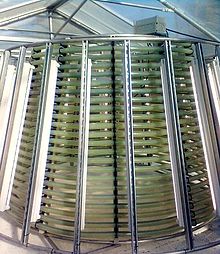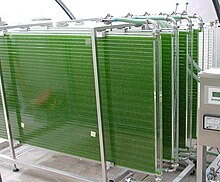Photobioreactor
A bioreactor is a plant for the production of microorganisms outside of their natural and within an artificial technical environment. The prefix “Photo” describes the ability of the bioreactor to cultivate phototrophic organisms, that is, to use light to generate their own energy. These organisms use the process of photosynthesis to build their own biomass from light and CO 2 . These organisms include plants, mosses, macroalgae, microalgae, cyanobacteria and purple bacteria. The main goal of a photobioreactor is the controlled provision of a habitat that offers the optimal living conditions for the respective organism. A photobioreactor enables significantly higher growth rates and purities than would be the case in a natural or nature-like environment. In principle, biomass can be produced in photobioreactors from wastewater containing nutrients and waste gases containing carbon dioxide .
Open versus closed systems
The first approach to the controlled rearing of phototrophic organisms was and is open ponds or basins, so-called open ponds or raceway ponds . The culture suspension, the liquid that contains all the nutrients and CO 2 necessary for the respective organism , is pumped in a circle and illuminated directly by the sun via the open surface. This design is the easiest way to breed phototrophic organisms, but only achieves low area-related growth rates due to the up to 30 cm deep basins and the resulting low average light input. In addition, the expenditure of pumping energy is relatively high, since a lot of water with a low product concentration has to be pumped.
In areas of the world where many people live, space is expensive; elsewhere, water is a scarce commodity, which is released into the atmosphere unused in the case of open construction. For these reasons, attempts have been made since the 1950s to develop closed systems in which the phototrophic organisms are grown to higher biomass densities and thus less water has to be pumped. In addition, with the closed design, there is no system-related water loss and the risk of contamination from landing water birds or dust entry is minimized.
Photobioreactor types
All modern photobioreactors have in common that the development is a balancing act between low layer thickness, optimal use of light, low pumping costs, low investment costs and microbial purity. This has led to multiple approaches, of which only a few systems have been able to assert themselves on the market.
Converted laboratory fermenter
The simplest approach is to convert classic glass fermenters, as they are often used on a biotechnological laboratory scale. One example of this is the moss reactor, in which an unsuitable glass vessel is supplied with light from the outside. The process values are monitored and the gas exchange carried out via the existing cover openings. This type can be found quite often on the laboratory scale, but has not made the leap to the production scale because of the limited container size.
Tube photobioreactors
One principle that has made the leap to production scale is the systems made up of pipes. Glass or plastic pipes are set up in a horizontal or vertical orientation and supplied by a central unit with a pump, sensors and nutrients or CO 2 . Systems based on this principle are established worldwide from laboratory sizes to production scale and are used, for example, for the production of the carotenoid astaxanthin from the green alga Haematococcus pluvialis or the production of food supplements from the green alga Chlorella vulgaris . The advantages of the systems are the high degree of purity and the good productivity in the system. Production can take place at a high quality level and the high dry matter content at the end of production enables energy-efficient processing. The relatively high price of the systems has a negative effect on the broad use of the biomass produced in this way. Economically viable concepts can only be found in high-priced products in food supplements and cosmetics.
In addition to the large-scale production of biomass, the advantage of tubular reactors is also used on a small-scale. In a combination of the above-mentioned glass container with a thin pipe coil, a relevant amount of biomass can also be generated on a laboratory scale, which grows under highly controlled conditions regulated by a complex control unit.
Christmas tree photobioreactor
An alternative approach describes the development of a photobioreactor, which, due to its frustoconical geometry and the helically attached, transparent double hose system, is similar to the structure of a fir tree and imitates its properties. The reactor system has a modular structure and can therefore also be scaled to agricultural standards in outdoor use. As with other tube photobioreactors, the choice of location is not decisive because of the closed design; therefore, in principle, non-agricultural land can also be used. In this reactor, a special material is intended to minimize the formation of bioburden during the cultivation of microalgae and thus achieve a high final biomass concentration. In combination with turbulence and the conception as a closed system, low-contamination operation with high system availability is achieved.
Plate photobioreactors
Another development approach is the construction of plastic or glass plates. Different shaped plates are arranged vertically or horizontally so that a thin layer of culture suspension between them provides the organisms with a good supply of light. In addition, the simpler design compared to tubular reactors enables the use of inexpensive plastic. In the meantime, meandering flow through, fumigated from below or particularly three-dimensional shaped plates, which promise good productivity, were implemented. Among other things, attempts are being made to track the panels in a similar way to photovoltaics , to further reduce the layer thickness or to convey them continuously, i.e. not in a closed circle, past light sources - both artificial light and sunlight are used. Unresolved challenges exist, for example, in the longevity of the material or in the formation of immobilizations. Large-scale use is additionally hindered by the limited scalability of the systems.
From April 2013, a house with glass plates integrated into the facade should go into operation as photobioreactors at the IBA in Hamburg.
Foil photobioreactors
In the course of reducing the price of photobioreactors, various systems made of films have also been designed. Cheap PVC or PE films are hung up in such a way that a culture suspension can be caught and held in them. These technologies set standards in terms of price, but the reactors are not very sustainable disposable items. In addition, an increased investment requirement due to the necessary mounting systems must be expected.
Perspectives of the photobioreactor development
In the course of discussion on the CO 2 - sequestration using microalgae or its use as a biofuel source is a great development pressure has emerged on the manufacturers of photobioreactors. To date, none of the aforementioned systems is able to produce phototrophically grown biomass at a price level that allows competition with fossil petroleum . New developments are, for example, in the direction of drip processes, in which ultra-thin layers using exhaust gas and wastewater should lead to maximum growth. There is also very intensive research on genetically modified microalgae worldwide. It remains to be seen whether a rising oil price will lead to a breakthrough.
literature
- C. Posten, C. Walter: Microalgal Biotechnology: Integration and Economy. de Gruyter, 2012, pp. 262–263.
- Ayhan Demirbas, M. Fatih Demirbas: Algae Energy: Algae as a New Source of Biodiesel Green Energy and Technology. Springer, 2010, p. 80.
- Otto Pulz: Photobioreactors: production systems for phototrophic microorganisms. In: Appl Microbiol Biotechnol. Volume 57, 2001, pp. 287-293. doi: 10.1007 / s002530100702
- Christine Rösch, Juliane Jörissen, Johannes Skarka, Nicola Hartlieb: Ways to reduce land use conflicts. In: TECHNICAL IMPACT ASSESSMENT - Theory and Practice. ed. from the Institute for Technology Assessment and Systems Analysis (ITAS) - Focus: Land use conflicts - causes, consequences and possible solutions. 17th volume, No. 2, September 2008, pp. 66–71.
- F. Cotta, M. Matschke, J. Grossmann, C. Griehl, S. Matthes: Process engineering aspects of a flexible, tubular system for algae production. DECHEMA 2011 (PDF)
- J. Ullmann, M. Ecke, K.-H. Steinberg: Industrial scale production of microalgae. 125th annual meeting of the German Botanical Society. 2007
- T. Wencker, O. Pulz: Photobioreactor design principles , Submariner Project Cooperation Event 2011 (PDF; 2.5 MB)
Individual evidence
- ↑ a b Eva L. Decker, Ralf Reski : Current achievements in the production of complex biopharmaceuticals with moss bioreactors. In: Bioprocess and Biosystems Engineering. Volume 31, No. 1, 2008, pp. 3-9. PMID 17701058 .
- ↑ Algae Observer: Algae in the desert - industrial algae cultivation .
- ^ Algae Observer: IGV Biotech Presents Novel Algae Screening System .
- ↑ art-magazin.de: IBA Hamburg - Opening - Energy Bunker, algae house, Weltquartier ( Memento of 28 March 2013, Internet Archive ).
- ↑ klima-luegendetektor.de: RWE: The truth under the algae carpet.
- ↑ Maren Schibilsky: Fuel from microalgae. Deutschlandfunk, September 21, 2012, accessed on February 4, 2015 .






